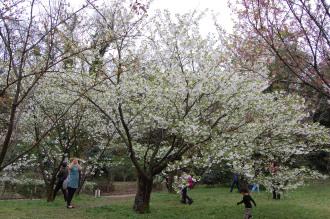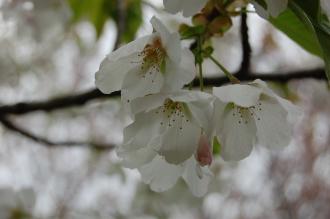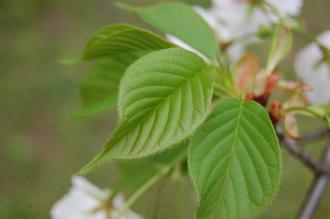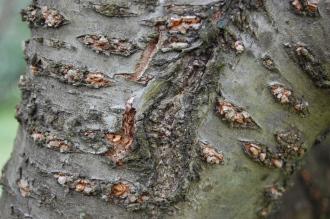
Prunus speciosa (04/04/2015, Kyoto Botanic Gardens, Kyoto)
Position: Full sun
Flowering period: Spring
Soil: Moist, well drained
Eventual Height: 12m
Eventual Spread: 12m
Hardiness: 7a, 7b, 8a, 8b, 9a, 9b
Family:Rosaceae

Prunus speciosa Flower (04/04/2015, Kyoto Botanic Gardens, Kyoto)
Prunus speciosa is a deciduous tree with a spreading habit. Its dark green leaves are elliptic with serrate margins, up to 10cm long and 6m broad. Its leaves turn yellow/ orange before they fall in autumn. Its white fragrant flowers are up to 4cm across and appear just before or at the same time as the leaves in clusters of up to 6. Its black fruit, the cherry, is a small globose drupe which is up to 1cm across.
Prunus speciosa, commonly known as Oshima Cherry, is native to south east Japan. This tree is one of the parents of the hybrid Prunus x yedoensis.

Prunus speciosa Leaf (04/04/2015, Kyoto Botanic Gardens, Kyoto)
The etymological root of the binomial name Prunus is from the classical name of the Plum tree. Speciosa is from the Latin meaning ‘spectacular’.
The landscape architect may find Prunus speciosa useful as an attractive spring flowering small tree.
Ecologically, Prunus speciosa flowers are attractive to pollinating insects. Its fruit are attractive to birds and mammals.

Prunus speciosa Bark (04/04/2015, Kyoto Botanic Gardens, Kyoto)
Prunus speciosa prefers moist, fertile, deep, well-drained soils. It tolerates most pH of soil. This tree dislikes dry soils.
Prunus speciosa requires little maintenance. Pruning should be carried out after flowering, from April to July to minimise the risk of Silver leaf infection.

